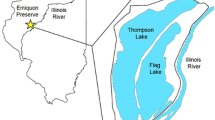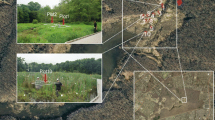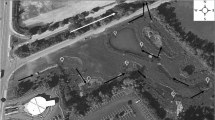Abstract
Restoring wetlands is expensive, and hydrology criteria are needed to determine if restored sites are saturated long enough to support the planted vegetation. This study determined relationships among hydrology, soils, and vegetation in a restored Carolina Bay wetland (CBW) to identify field indicators of saturation duration. The study site was in Robeson County, NC in a CBW that had been restored for 15 years. Water-table data for the five-year period following restoration were used to establish saturation periods of: ≤13, 14-50, 51-100, and 101-225 consecutive days occurring during the growing season and within 30 cm of the surface. Sampling plots were established 15 years after restoration along a hydrologic gradient to identify vegetation type, tree basal area, tree height, wetland hydrology field indicators, and inundation. The number of hydrology field indicators increased 50%, going from ≤13 to 101-225 days of saturation. Dominant tree species at the restored site were similar to those found in three reference CBWs. Where saturation occurred for 101+ days, tree basal area and height decreased 40-69% compared to where saturation periods were shorter. Areas that experienced saturation for <51 days contained trees that were 10 cm larger in diameter, had more shrubs and vines, and contained less areal cover of graminoids compared to areas that had saturation for 101- 225 days. Regression equations predicted average saturation duration during the growing season using number of hydrologic field indicators and tree height with R2 values between 0.62 and 0.73. Such relationships would be useful to evaluate restoration success.


Similar content being viewed by others
Data Availability
The datasets used and/or analysed during the current study are available from the corresponding author on reasonable request.
Code Availability
Not applicable.
References
Bruland GL, Hanchey M, Richardson C (2003) Effects of agriculture and wetland restoration on hydrology, soils, and water quality of a Carolina bay complex. Wetlands Ecology and Management 11:141–156
Caldwell PV, Vepraskas M, Gregory J, Skaggs R, Huffman R (2011) Linking plant ecology and long-term hydrology to improve wetland restoration success. Advances in Forest Hydrology 54:2129–2137
Collins M, Kuehl R (2001) Organic matter accumulation and organic soils. In: Richardson J, Vepraskas M (eds) Wetland soils: genesis, hydrology, landscapes, and classification. Lewis Publ., Boca Raton, pp 137–162
Conner WH, Buford MA (1998) Southern Deepwater Swamps. In: Messina MG, Conner WH (eds) Southern forested wetlands ecology and management. Lewis Publishers, Boca Raton, pp 261–287
De Steven D, Lowrance R (2011) Agricultural conservation practices and wetland ecosystem services in the wetland-rich Piedmont‐Coastal Plain region. Ecological Applications 21:S3–S17
DeYoung J (2018) Forest measurements: an applied approach. In DeYoung J (ed) Field technique tips for measuring tree height, 1st edn. Morrisville, NC, pp 55–61
Dimick BP, Stucky J, Wall W, Vepraskas M, Wentworth T, Arellana C (2010) Plant-soil‐hydrology relationships in three Carolina bays in Bladen County, North Carolina, USA. Castanaea 75(4):407–420
Environmental Services, Inc (2006-2010) Juniper Bay Wetland Mitigation Site. NC DEQ: DMS Project Documents. https://deq.nc.gov/es/about/divisions/mitigation-services/dms-projects. Accessed 1 Feb 2019
Esri (2016) Arcmap version 10.4. Esri Products, Redlands
Ewing J, Vepraskas M (2006) Estimating primary and secondary subsidence in an organic soil 15, 20, and 30 years after drainage. Wetlands 26(1):119–130
Ewing J, Vepraskas M, Zanner C (2005) Using historical records of land use to improve wetland mitigation. Southeastern Geographer 45:25–43
Ewing J, Vepraskas M, White J, Broome S (2012) Changes in wetland soil morphological and chemical properties after 15, 20, and 30 years of agricultural production. Geoderma 179–180:73–80. https://doi.org/10.1016/j.geoderma
Hall T, Penfound W (1939) A phytosociological study of a Nyssa biflora consocies in southeastern Louisiana. American Midland Naturalist 22:369–375
Kusler J, Kentula M (1990) Executive summary. Wetland creation and restoration: The status of the science. Island Press, Washington, DC, pp xvii–xxv
McCachren C (1978) Soil survey of Robeson county, North Carolina. United States Department of Agriculture, Soil Conservation Service, Washington, D.C.
Mitsch W, Gosselink J (2007) Wetlands, 4th edn. Wiley, New York
National Oceanic and Atmospheric Administration (2020) NRCS field office technical guide: climate data for Lumberton, North Carolina. United States Department of Agriculture, Natural Resources Conservation Service, Washington, DC. http://agacis.rcc-acis.org/. Accessed 10 Nov 2020
National Research Council (1995) Wetlands: characteristics and boundaries. National Academy Press, Washington, D.C.
NC Department Environmental Quality (2020) Division of Mitigation Services: Projects, Juniper Bay (no. 201). https://deq.nc.gov/division-mitigation-services-projects. Accessed 21 Sept 2021
Otte L (1982) Origin, development, and maintenance of the pocosin wetlands of North Carolina. Raleigh
Reed P (1988) National list of plant species that occur in wetlands. U.S. Fish and Wildlife Service. Washington, D.C
Studio R (2017) PBC R version 3.6.1. The r foundation for statistical computing, Boston
SAS Institute (2013) SAS version 9.4. SAS Institute, Cary
United States Army Corps of Engineers (2002) Regulatory guidance letter no. 02-2. http://www.swg.usace.army.mil/reg/mitigation/map-rgl/rgl_02-2.pdf. Accessed 11 Jan 2022
United States Army Corps of Engineers (2005) Technical standard for water-table monitoring of potential wetland sites. Wetlands Regulatory Assistance Program, ERDC TN-WRAP-05-2:12
United States Army Corps of Engineers (2010) Regional supplement to the Corps of Engineers Wetland Delineation Manual: Atlantic and Gulf Coastal Plain Region (Version 2.0), Wakeley JS, Lichvar RW, Noble CV (eds). ERDC/EL TR-10-20.U.S. Army Engineer Research and Development Center. Vicksburg
United States Department of Agriculture – Natural Resources Conservation Service (USDA-NRCS) (1994) National food security act manual, third edition (as amended). Washington, D.C
United States Department of Agriculture (2002) Wetland reserve program: restoring America’s wetlands. USDA Natural Resources Conservation Service, Washington, D.C.
United States Department of Agriculture – Natural Resources Conservation Service (2020) Plant Database Search Engine. https://plants.usda.gov/java/. Accessed July 2020
Wentworth T, Johnson G, Kologiski R (1988) Designation of wetlands by weighted averages of vegetation data: a preliminary evaluation. Water Resources Bulletin 24:389–396
Acknowledgements
The USDA Natural Resources Conservation Service assisted in collecting vegetation data and their help is greatly appreciated. We also thank an anonymous reviewer for a thorough editing of the manuscript.
Funding
The United States Department of Agriculture – Natural Resources Conservation Service (USDA-NRCS) supplied the funding for this project.
Author information
Authors and Affiliations
Contributions
All authors contributed to the study’s design. MJV and MCR secured funding. CMM completed field work, and along with MJV analyzed the data and prepared the initial draft of the manuscript. All authors edited the final manuscript.
Corresponding author
Ethics declarations
Conflicts of Interest/Competing Interests
None.
Ethics Approval
Not applicable.
Consent to Participate
Not applicable.
Consent for Publication
Not applicable.
Additional information
Publisher’s Note
Springer Nature remains neutral with regard to jurisdictional claims in published maps and institutional affiliations.
Supplementary Information
Below is the link to the electronic supplementary material.
ESM 1
(DOCX 24 kb)
Rights and permissions
About this article
Cite this article
Moritz, C.M., Vepraskas, M.J. & Ricker, M.C. Hydrology and Vegetation Relationships in a Carolina Bay Wetland 15 Years after Restoration. Wetlands 42, 8 (2022). https://doi.org/10.1007/s13157-022-01530-0
Received:
Accepted:
Published:
DOI: https://doi.org/10.1007/s13157-022-01530-0




